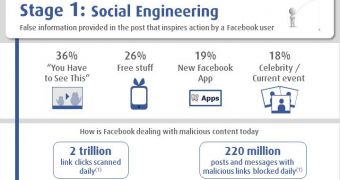Facebook attacks were not uncommon in 2011 and the figures revealed that cybercriminals may have made millions with the help of some clever technology, but also with the help of unsuspecting members who clicked on anything they thought to be interesting.
The numbers show that social engineering is an important part of Facebook schemes. “You have to see this” posts, free stuff, new apps and celebrities represent the perfect bait, Commtouch Café reports.
At the moment, the social networking site scans 2 trillion link clicks and blocks 220 million posts and messages they detect as containing malicious links, but believe it or not, they’re having a hard time keeping up with all the scams.
To spread their threats, cyber masterminds rely not only on unsuspecting users who are willing to Share and Like a post to claim an inexistent prize or to see some celebrity’s leaked tape. In 52% of cases cybercriminals rely on Likes and Shares generated by likejacking, malicious scripts and malware.
Statistically speaking, if each Facebook customer has on average 130 friends and 5 of them fall for a scam, in a matter of a few hours close to 10 million people join the infection chain.
Many are still unaware of these social media schemes and even if they fall for one they think that they can’t be harmed, but that’s completely untrue.
Around 74% of malicious posts and messages lead to fraudulent marketing affiliate and survey sites that earn a certain amount of money for the crooks each time they dupe a user into clicking on a link. Some of them request large amounts of personal information which can be utilized for other malevolent purposes, and a smaller percentage (6%) directly spread malware.
Facebook members are advised to stay away from suspicious posts and messages even if they come from friends. They’re also recommended not to provide sensitive information and ignore apps that make ludicrous claims like “learn who’s stalking you.”

 14 DAY TRIAL //
14 DAY TRIAL //